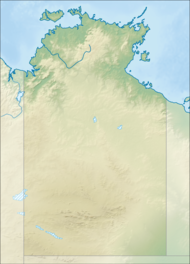Watarrka National Park is a protected area in the Northern Territory of Australia, which contains the popular Kings Canyon (Watarrka).
| Watarrka National Park Petermann[1], Northern Territory | |
|---|---|
 | |
| Nearest town or city | Yulara |
| Coordinates | 24°16′47″S 131°33′30″E / 24.27972°S 131.55833°E |
| Established | 31 July 1989[2] |
| Area | 1,051.85 km2 (406.1 sq mi)[2] |
| Visitation | 176,100 (in 2022)[3]: 3 [4] |
| Managing authorities | Parks and Wildlife Commission of the Northern Territory |
| Website | Watarrka National Park |
| See also | Protected areas of the Northern Territory |
Location
editThe park is located about 1,316 km (818 mi) south of Darwin and 323 km (201 mi) southwest of Alice Springs.[3]: 3
History
editWatarrka National Park was established in 1989, on the traditional lands of the Matutjara people.[5] It is named after the Aboriginal (Luritja and Arrernte[6]) name for Kings Creek and Canyon watarrka (pronounced what-ARR-kah[7]). This is the Luritja word for the local umbrella bush (Acacia ligulata) that grows in the vicinity.[8]
The park was established on land owned by England-born Jack Cotterill and his two sons, Jack and Jim, who opened it up for tourism from their property, Wallara Ranch.[9]
Description
editThe national park is categorised as an IUCN Category II protected area.[2] On 25 March 1986, it was listed on the now-defunct Register of the National Estate.[10][11]
It contains the popular Kings Canyon (Watarrka) at the western end of the George Gill Range and Kathleen Springs, around 21 km (13 mi) to the southeast of Kings Canyon.[5]
In 1986, Kings Canyon was described by the Department of Environment as follows:[10]
One of the most spectacular canyons in Central Australia. Kings Canyon contains some 60 rare or relict plant species and a total of 572 different plant species and 80 species of birds. It is a 'living plant museum' and is notable for its stands of cycads & permanent rock pools. There are some well-preserved Aboriginal paintings and engravings in the area...
Climate
edit| Climate data for Watarrka, elevation 614 m (2,014 ft), (1991–2020 normals) | |||||||||||||
|---|---|---|---|---|---|---|---|---|---|---|---|---|---|
| Month | Jan | Feb | Mar | Apr | May | Jun | Jul | Aug | Sep | Oct | Nov | Dec | Year |
| Mean daily maximum °C (°F) | 38.4 (101.1) |
36.9 (98.4) |
35.1 (95.2) |
30.9 (87.6) |
25.0 (77.0) |
21.4 (70.5) |
22.0 (71.6) |
24.5 (76.1) |
29.7 (85.5) |
33.1 (91.6) |
35.1 (95.2) |
36.4 (97.5) |
30.7 (87.3) |
| Mean daily minimum °C (°F) | 23.5 (74.3) |
23.0 (73.4) |
20.8 (69.4) |
16.7 (62.1) |
10.9 (51.6) |
6.4 (43.5) |
6.1 (43.0) |
8.2 (46.8) |
13.2 (55.8) |
17.5 (63.5) |
19.8 (67.6) |
22.0 (71.6) |
15.7 (60.2) |
| Average rainfall mm (inches) | 45.7 (1.80) |
39.8 (1.57) |
29.2 (1.15) |
12.8 (0.50) |
16.8 (0.66) |
14.6 (0.57) |
13.4 (0.53) |
5.8 (0.23) |
10.0 (0.39) |
24.8 (0.98) |
44.7 (1.76) |
39.5 (1.56) |
297.1 (11.7) |
| Average rainy days (≥ 1.0 mm) | 3.8 | 3.5 | 2.2 | 1.8 | 2.1 | 1.7 | 1.6 | 1.1 | 1.8 | 3.1 | 4.5 | 5.2 | 32.4 |
| Source: Australian Bureau of Meteorology[12] | |||||||||||||
See also
editReferences
edit- ^ "Petermann". NT Atlas and Spatial Data Directory. Northern Territory Government. February 2005. Retrieved 19 June 2019.
- ^ a b c d "CAPAD 2012 Northern Territory Summary (see 'DETAIL' tab)". CAPAD 2012. Australian Government - Department of the Environment. 7 February 2014. Retrieved 7 February 2014.
- ^ a b Watarrka National Park Joint Management Plan July 2018 (PDF). Traditional Owners and Parks and Wildlife Commission of the Northern Territory. July 2018. p. 3. ISBN 9781743501429.
- ^ "Park visitor data". Department of Tourism Sport and Culture. Northern Territory Government. Retrieved 19 June 2019.
...Traffic counters located along Luritja Road at two separate entry points...
- ^ a b "Watarrka National Park". Norther. 9 February 2022. Retrieved 10 April 2023.
- ^ "Kings Canyon Tourism". Discover Central Australia. Retrieved 10 April 2023.
- ^ "Kings Canyon Watarrka - Better than Uluru?". Travel Outback Australia. 27 January 2022. Retrieved 10 April 2023.
- ^ "Watarrka". Central Art Aboriginal Art Store (in Indonesian). Retrieved 10 April 2023.
- ^ O'Loughlin, Genny. An early pioneer: Watarrka National Park: Jack Cotterill will not be forgotten (PDF). Archived (PDF) from the original on 26 March 2019.
- ^ a b "Watarrka (Kings Canyon) National Park, Ernest Giles Rd, Yulara (sic), NT, Australia - listing on the now-defunct Register of the National Estate (Place ID 190)". Australian Heritage Database. Australian Government. 25 March 1986. Retrieved 19 June 2019.
- ^ "COMMONWEALTH OF AUSTRALIA Australian Heritage Commission Act 1975 NOTICE OF ENTRY IN THE REGISTER OF THE NATIONAL ESTATE". Commonwealth of Australia Gazette. Special. No. S127. Australia. 25 March 1986. p. 25. Retrieved 20 June 2019 – via National Library of Australia.
Kings Canyon National Park, …72,400 ha, located 325 km west of Alice Springs
- ^ "Climate statistics for Australian locations- WATARRKA". 7 April 2024.
- This article incorporates text by Commonwealth of Australia available under the CC BY 3.0 AU licence.
External links
edit
